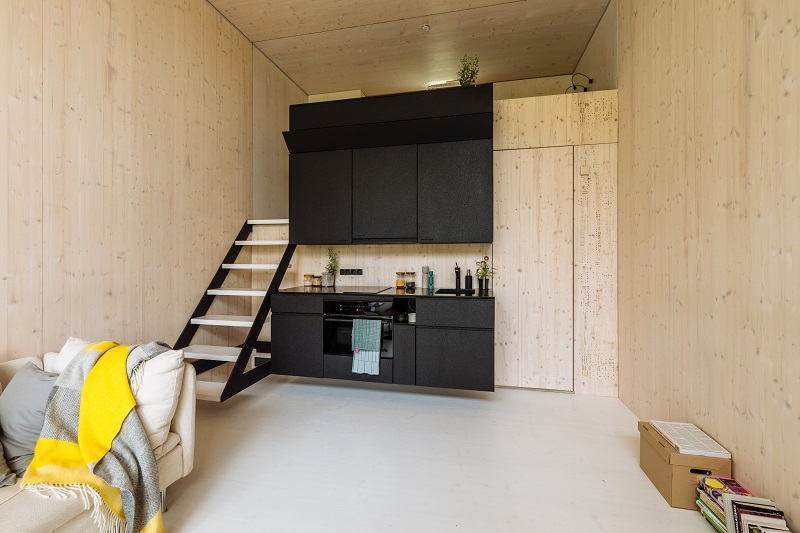KODA house
In July 2016, the Estonian design collective Kodasema unveiled KODA, their prototype for an innovative mobile house.
The small prefabricated unit is designed to allow residents to relocate in less than a day.
In June 2017, it was announced that BRE would be collaborating with the embassy of Estonia to launch the KODA house in London. This follows the design being a winner of WAN Urban Challenge 2017, a global ideas competition with a focus on London’s housing crisis.
With a footprint of only 25 sq. m, KODA contains an open-plan living space and mezzanine bedroom, as well as a glazed frontage and built-in terrace.
The building's quadruple-glazed facade serves to maximise natural light while preventing heat loss.
Directly behind the glazing is a small lounge area, with a kitchen and bathroom set towards the back of the unit to allow more privacy. The sleeping area, which is just big enough for a bed, is reached via a ladder from the kitchen.
Although occupants are encouraged to find a site with suitable water, sewage and electricity provision, the house is designed to generate and conserve its own energy. This enables it to be used in remote settings for short periods of time. Roof-mounted solar panels are intended to return more power than is used to the grid.
The house is constructed with factory-made components, and can be built on site without the need for foundations.
Kodasema said: "Much of our quality of life depends on both our home and its location meeting our needs. When choosing where to live however, we may take risks on both fronts. It can be difficult to make major changes to a conventional home as inconvenient and extensive repairs are often involved, or even full demolition and reconstruction.
"In our minds KODA can become whatever you want – a city-centre home, a lakeside summer house, a cosy café, an office, workshop or studio or even a classroom. Its clever design provides the inspiration to make best use of every square inch of space and envisage how the built-in components, even the walls, can be adjusted to meet their purpose most effectively."
KODA was first exhibited at the Tallinn Architecture Biennale in 2015, and has been shortlisted for the Small Project prize at the World Architecture Festival 2016.
With the London launch, BRE hope that KODA will shake up the property market by providing a high-end space that can be used as a city centre home, a lakeside summer house, an office, workshop or studio or even a classroom.
Content courtesy of Kodasema.
All images copyright Tõnu Tunnel.
[edit] Find out more
[edit] Related articles on Designing Buildings Wiki
- Cube Houses.
- Disposable Houses.
- Hex House project.
- Humanitarian shelter exhibition.
- Kit house.
- Modular buildings.
- Prefabrication.
- Prenuptial Housing.
- SHED concept.
- Structure relocation.
- Sustainability in building design and construction.
- Upside Down House, Poland.
- Urban Rigger.
- Wikkelhouse.
- Wiki house.
- Y Cube.
Featured articles and news
RTPI leader to become new CIOB Chief Executive Officer
Dr Victoria Hills MRTPI, FICE to take over after Caroline Gumble’s departure.
Social and affordable housing, a long term plan for delivery
The “Delivering a Decade of Renewal for Social and Affordable Housing” strategy sets out future path.
A change to adoptive architecture
Effects of global weather warming on architectural detailing, material choice and human interaction.
The proposed publicly owned and backed subsidiary of Homes England, to facilitate new homes.
How big is the problem and what can we do to mitigate the effects?
Overheating guidance and tools for building designers
A number of cool guides to help with the heat.
The UK's Modern Industrial Strategy: A 10 year plan
Previous consultation criticism, current key elements and general support with some persisting reservations.
Building Safety Regulator reforms
New roles, new staff and a new fast track service pave the way for a single construction regulator.
Architectural Technologist CPDs and Communications
CIAT CPD… and how you can do it!
Cooling centres and cool spaces
Managing extreme heat in cities by directing the public to places for heat stress relief and water sources.
Winter gardens: A brief history and warm variations
Extending the season with glass in different forms and terms.
Restoring Great Yarmouth's Winter Gardens
Transforming one of the least sustainable constructions imaginable.
Construction Skills Mission Board launch sector drive
Newly formed government and industry collaboration set strategy for recruiting an additional 100,000 construction workers a year.
New Architects Code comes into effect in September 2025
ARB Architects Code of Conduct and Practice available with ongoing consultation regarding guidance.
Welsh Skills Body (Medr) launches ambitious plan
The new skills body brings together funding and regulation of tertiary education and research for the devolved nation.
Paul Gandy FCIOB announced as next CIOB President
Former Tilbury Douglas CEO takes helm.
UK Infrastructure: A 10 Year Strategy. In brief with reactions
With the National Infrastructure and Service Transformation Authority (NISTA).



























